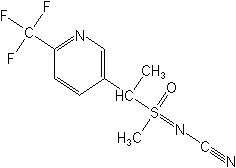Note from Fluoride Action Network
Structural formula for Sulfoxaflor (see more information on its toxicity and USDA Shuts Down Data Collection on Honey Bees) and Sulfoxaflor: Documents.

A federal appeals court has handed a victory to environmentalists challenging the EPA’s registration of the insecticide, sulfoxaflor. The verdict also denies a request by the Agency to remand the approval to allow it to complete the required review of the potential impacts of legal uses of the insecticide on endangered species.
The US Court of Appeals rejected the EPA’s motion to remand without comment, laying out a schedule for the case to proceed and for it to consider whether the Agency’s 2019 registration amendments for sulfoxaflor violated the Federal Insecticide, Fungicide and Rodenticide Act (FIFRA), and the Endangered Species Act (ESA).
Disputed data
In its September 2015 ruling, the Court found that the EPA had relied on “flawed and limited” data when it issued the registration and failed to adequately assess the impacts on pollinators. The Court called on the EPA to vacate the registration and obtain further studies and data regarding the effects of sulfoxaflor on bees.
The EPA revoked Dow’s registration in November 2015 and then granted an amended approval in October 2016 for uses on crops that are not attractive to bees―the new licence imposed several restrictions, including buffer zones and prohibitions on tank mixing.
In July 2019, the EPA issued another registration, scrapping those mitigation measures and reinstating approvals for use on bee attractive crops―namely citrus, cotton, cucumbers, soybeans, squash, strawberries, and water melons. The registration order also permitted new uses on several grains, including millet and oats, as well as on alfalfa, cacao, maize, pineapple, sorghum, and tree plantations.
Agency officials said that the benefits to growers far outweighed the risks, and more than a dozen new industry studies found little potential harm to pollinators and no need for the past restrictions. New product labels include warnings that the insecticide is “highly toxic to bees and other pollinating insects” and instructions to minimise drift, notify nearby beekeepers of planned applications and time limits on when to spray.
The EPA also required additional restrictions on citrus, flowers and some fruits to further protect bees and other pollinators.
The environmentalist groups returned to the Ninth Circuit in August 2019 with another lawsuit, alleging that the EPA had failed to provide the public an opportunity to comment on the 2019 registration as required under the FIFRA and ignored its obligations under the ESA.
Rare call for remand
The EPA moved to shift the debate in October 2020, acknowledging that it had failed to complete the required ESA review and asking the court to remand the registration to allow it to carry out its obligations. The Agency warned that farmers could turn to more harmful alternatives if sulfoxaflor was pulled from the market and suggested that it begin the ESA assessment by 2025.
The EPA argued that the ESA review could lead to additional actions under the FIFRA and said that the Court retain jurisdiction to allow for review of the pesticide law claims after the ESA analysis is complete.
“Thus, EPA is not seeking to ‘get out of jail free’ or otherwise evade review,” the Agency told the Court.
The plaintiffs―along with a coalition of 11 states―pushed back, arguing that a remand would allow the EPA to indefinitely dodge legal review of the FIFRA allegations and urging the Ninth Circuit to deny the EPA’s request.
The Court’s order calls on the petitioners to file their opening briefs by February 16th.
